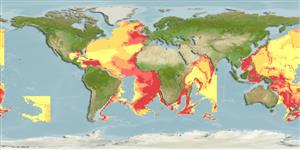>
Gadiformes (Cods) >
Macrouridae (Grenadiers or rattails)
Etymology: Cetonurus: Greek, ketos = a marine monster, whale + Greek, oura = tail (Ref. 45335).
More on author: Vaillant.
Environment: milieu / climate zone / depth range / distribution range
Ökologie
seewasser bathypelagisch; tiefenbereich 860 - 4621 m (Ref. 11953), usually 1000 - 2000 m (Ref. 3587). Deep-water
Atlantic and Pacific: Eastern Atlantic: Bay of Biscay, Azores, off Mauritania, Senegal, and Canary Islands, Western Atlantic: Gulf of Mexico, east Caribbean. Western Pacific: Off Japan and Indonesia.
Size / Gewicht / Alter
Maturity: Lm ? range ? - ? cm
Max length : 50.0 cm TL Männchen/unbestimmt; (Ref. 3587)
Kurzbeschreibung
Morphologie | Morphometrie
Rückenflossenweichstrahlen (insgesamt): 9-12. Band of small pointed teeth in both jaws. Body color brown to dark brown, gular and branchiostegal membrane darker. Membranes of mouth, gill cavities and body cavity blackish (Ref. 37108).
Feeds on small fishes and planktonic crustaceans (Ref. 6187).
Life cycle and mating behavior
Geschlechtsreife | Fortpflanzung | Ablaichen | Eier | Fecundity | Larven
Iwamoto, T. and A. Williams, 1999. Grenadiers (Pisces, Gadiformes) from the continental slope of western and northwestern Australia. Proc. Calif. Acad. Sci. 51(3):105-243. (Ref. 35909)
IUCN Rote Liste Status (Ref. 130435)
Bedrohung für Menschen
Harmless
Nutzung durch Menschen
Mehr Information
NamenSynonymeMetabolismusRäuberÖkotoxikologieFortpflanzungGeschlechtsreifeAblaichenSpawning aggregationFecundityEierEientwicklung
Alter/GrößeWachstumLänge-GewichtLänge-LängeLängenhäufigkeitenMorphometrieMorphologieLarvenLarven Pop.Dyn.RekrutierungDichteBRUVS
ReferenzenAquakulturAquakultur ProfilZuchtlinienGenetikElectrophoresesVererbbarkeitKrankheitenVerarbeitungNutrientsMass conversion
Tools
Zusatzinformationen
Download XML
Internet Quellen
Estimates based on models
Preferred temperature (Ref.
123201): 2.3 - 6, mean 3.7 °C (based on 2783 cells).
Phylogenetic diversity index (Ref.
82804): PD
50 = 0.7500 [Uniqueness, from 0.5 = low to 2.0 = high].
Bayesian length-weight: a=0.00102 (0.00046 - 0.00225), b=3.06 (2.88 - 3.24), in cm total length, based on all LWR estimates for this body shape (Ref.
93245).
Trophic level (Ref.
69278): 3.9 ±0.60 se; based on food items.
Widerstandsfähigkeit (Ref.
120179): sehr niedrig, Verdopplung der Population dauert mehr als 14 Jahre. (Preliminary K or Fecundity.).
Fishing Vulnerability (Ref.
59153): Moderate vulnerability (40 of 100).
